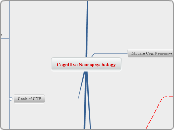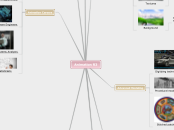UML Basics
diagrams
(nodes are elements, edges are relationships)
static deployment view
deployment
is related to component diagram w/ nodes hosting one or more components
shows configuration of run-time processing nodes and the components hosted on them
static implementation view
shows how components map to one or more class, interface and collaborations
shows the organization and dependencies amongst a set of components
dynamic view
activity
for modeling system's functions
shows control/data flows from activity to another
statechart
emphasizes the event-driven ordering
shows state machine consisting of states, transitions, events and activities
interaction diagrams
shows structural organization of objects that send & receive msgs
sequence
emphasis on the chronological ordering of messages
set of objects and the messages sent and received by them
static view
object
static snapshot of element instances found in class diagram
organizing and modeling the external behaviour of the system
relationships
realization
dashed arrow w/ hollow head
two basic scenarios
use cases Vs realizing collaborations
interfaces Vs realizing classes/components
one element specifies a contract and another guarantees to carry it out
generalization
solid line w/ hollow arrowhead pointing to parent
child share the structure/behaviour of the parent
objects of a specialized element (child) are substitutable for objects of a generalized element (parent)
associations
solid line labelled w/ adornments (multiplicity and role names)
aggregation is a special type of it
describing a set of links bw objects
dependency
directed dashed line (w/ label)
a change in one element may affect the meaning of another
UML background
UML goals
recommended with processes:
incremental
iterative
architecture-centic
use case driven
UML is process independent
what is UML?
fo modeling: enterprise info. systems, distributed web-based, real time embedded etc.
language for visualizing, specifying, constructing and documinting artifacts of sw-intensive systems
artifacts: requi. architecture, design, source code, test cases etc.
unified modeling language
modeling principles
why model?
modeling
providing a bluprint of a system
representation or simplification of reality
elements
annotation
rectangle with dog-eared corner
comments (text and graphical) added to models for better explanation
note
grouping
tabbed folder
conceptual, only available at development time
organizes diagrams
package of classes or components
behavioural
state machine
rounded rectangle with a name and sub-states
includes a number of elements
activities
events
transition
states
a sequance of states an object or interacton goes through during its lifetime
interaction
an arrow
involve a number of other elements
links (connection bw obj)
action sequences (behaviour invoked by a message)
messages
a set of messages exchanged among a set of objects
verb
structural
kinds
node
cube
may contain a set of components that may migrate from one node to another
represents a computational resource w/memory and processing capacity
a physical element exists at run time
component
repreasents a physical packaging of logical elements such as classes, interfaces and collaborations
repreasents deployment components (COM+ java beans)
physical replaceable part of a system (app, files,libraries, pages, tables)
active class
drawn like a class but w/ thick line
a class whose objects have concurrent behaviour w/ other objects
a class whose objects own one or more processe and can initiate an action
collaboration
named ellipse drawn w/ a dashed line
interaction bw elements
interface
circle with name
defines a set of operations but not their implem.
describes the externally visible behaviour of a class
operations that specifies a service of a class
class
rectangle
use case
named (verb) ellipse drawn w/solid line
used to stucture the behavioural elements in a model
description of sequence of actions a sys performs to deliver results to an actor
noun
static part, represent conceptual elements









